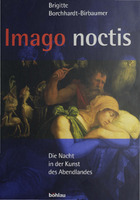Imago noctis
Die Nacht in der Kunst des Abendlandes
Author(s)
Borchhardt-Birbaumer, Brigitte
Collection
Austrian Science Fund (FWF)Language
GermanAbstract
For the first time in scholarly art history we can offer now a systematical overview on the representation of night in her manifold appearances and manifestations, attributes and connections covering the time from the Ancient Orient, the Greek, the Roman World Empire, Early Christian, Middle Ages and Renaissance up to the Baroque. Intended is a sequel from the Enlightenment and the Romantic Movement up to modern times.
Despite arranging the subject-matter in historical sections according to their chronological order it was necessary to take a not one-sided approach and to cope with thorough studies of single phenomenons. Therefore, viewpoints from many neighbour fields influenced interpretation and analysis. Far beyond their aesthetical function representations of night are linked as well as to literature as to religious, philosophical, astrological and theological ideas, e.g. night ranked in ancient times as the very - feminine - origin of entity which from arose the masculine day. Various like her appearances are also her colours. The Baroque era did not connect the night with black or blue as earlier periods did but with brown instead. Night may show herself as personification or as "natural" night, for example, as a moon landscape. The oldest known Nachtstück, a fisherboat on a lake with reed and crescent, has been preserved on a pre-babylonian seal done in the beginning of the third millenium B.C. Night may symbolize the positive aspects of life, yet also stands for threatening powers (death, witchcraft, nightmare) and low instincts (base eroticism): Sometimes both is valid like in the case of sleep. Night and light belong together. In drawing from the shadow produced by a source of light in a dark room according to an old belief visual art came into existence. Among the newly acquired findings stands out the Nachtfleiß (diligence at night) which formed a much appreciated theme of pictures in the Renaissance. This means the nocturnal labor of princes, artists and scientists, who in burning the midnight oil rise above ordinary people. The study not only integrates into a survey many works of eminent artists but also investigates and explains with regard to specific categories dealing among others with Michelangelo ("…I am a child of night"), Raphael, El Greco, Rubens and Caravaggio. Additionally several hitherto little known or entirely neglected paintings, drawings, prints and sculptural works are widening the point of view. While project work still was in progress some possibilities of cooperation with relevant exhibitions and broadcasts were utilized. B.Borchhardt's catalogue contributions ("Die Nacht", Munich 1998, "Nightscapes", Ulm 2001) summarize in due form the most important insights. Erstmals in der Kunstgeschichtsschreibung liegt eine systematische Übersicht über die Darstellung der Nacht in ihren vielfältigen Erscheinungsformen, Attributen und Verknüpfungen im Zeitraum vom Alten Orient über Ägypter, Griechen, das römische Weltreich, Frühchristentum, Mittelalter und Renaissance bis zum Barock vor. Eine Fortsetzung, die von der Aufklärung und Romantik bis zur Moderne reicht, ist geplant.
Trotz der Gliederung in historische Abschnitte nach deren zeitlicher Reihenfolge mußte der methodischen Vielfalt durch fachübergreifende und gründliche Studien von Einzelphänomenen Rechnung getragen werden. Deshalb sind auch Gesichtspunkte aus vielen Nachbarwissenschaften berücksichtigt. Nachtdarstellungen sind weit über ihre ästhetische Funktion hinaus mit religiösen, philosophischen, astrologischen und theologischen Vorstellungen verbunden, z.B. wurde die Nacht in der Antike als das - weibliche - Urprinzip verstanden, aus welchem der männliche Tag entsprang. Mannigfach wie ihre Erscheinungsformen sind auch ihre Farben. Die Barockzeit sah die Nacht nicht wie frühere Epochen blau oder schwarz, sondern braun. Die Nacht kann als Personifikation erscheinen oder als "natürliche" Nacht, etwa in Form einer Mondlandschaft. Das älteste bisher bekannte "Nachtstück" in Gestalt eines Fischerboots auf einem See mit Schilfrohr und Mondsichel ziert ein vorbabylonisches Siegel aus dem frühen 3.Jahrtausend v.Chr. Nacht kann positive Aspekte des Lebens meinen, steht aber auch für bedrohliche Mächte (Tod, Hexenkunst, Alptraum) und niedere Triebe (primitive Erotik). Mitunter kann - wie beim Schlaf - auch beides zutreffen. Nacht und Licht gehören zusammen. Indem der durch eine Lichtquelle in nachtdunklem Raum erzeugte Schatten nachgezeichnet wurde, entstand nach altem Glauben die bildende Kunst. Zu den neu erarbeiteten Erkenntnissen gehört vor allem der in der Renaissance als Bildthema beliebte Nachtfleiß, das nächtliche Schaffen von Fürsten, Künstlern und Wissenschaftlern, die sich damit über die gewöhnliche Masse erheben. Zahlreiche Werke bedeutender Künstler sind nicht nur überblicksmäßig geordnet, sondern nach Kategorien untersucht und erläutert, u.a. Michelangelo ("...ich bin ein Kind der Nacht"), Raffael, El Greco, Rubens und Caravaggio. Darüber hinaus erweitern etliche bisher wenig oder nicht bekannte Gemälde, Graphiken und Bildhauerarbeiten den Blickwinkel.
Während die Forschungsarbeiten zum Projekt noch im Gang waren, ergab sich die Möglichkeit zu Kooperation bei einschlägigen Ausstellungen und Rundfunksendungen. In den Katalogbeiträgen von B.Borchhardt ("Die Nacht", München 1998; "Nightscapes", Ulm 2001) sind wichtige Erkenntnisse in kurzer Form zusammengefaßt.
Keywords
representation of night; Darstellung der NachtDOI
10.26530/oapen_574826ISBN
9783205770527OCN
1030813722Publication date and place
2003Grantor
Imprint
BöhlauClassification
History of art


 Download
Download